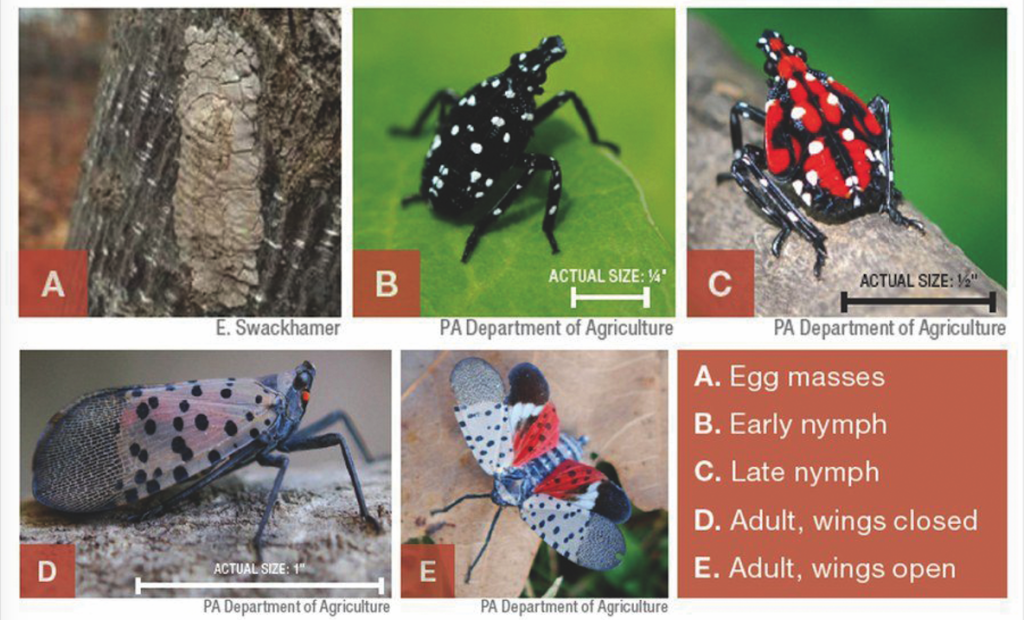by Kate Evans
The invasive spotted lanternfly (Lycorma delicatula) continues to expand its range and threaten fruit trees, grape vineyards, hardwood trees and crops in a number of eastern states, including West Virginia, Pennsylvania, Maryland and Virginia. The insect was first found in Pennsylvania in 2014.
The spotted lanternfly was first sighted in Berkeley County in October 2019 and in Jefferson County in May 2021. It was first reported in Morgan County in late September 2021. Washington and Frederick Counties were added to the Maryland quarantine list for spotted lanternfly in January 2022.
Agriculture officials have said that if the spotted lanternfly is allowed to spread that it could severely impact the country’s grape orchards, fruit trees, plant nurseries, ornamental trees and forest industries.
Spotted lanternfly populations are currently found in 14 states. Those states are Connecticut, Delaware, Indiana, Maryland, Massachusetts, Michigan, New Jersey, New York, North Carolina, Ohio, Pennsylvania, Rhode Island, Virginia and West Virginia. All states are asking for the public’s help in watching for the insect and stopping its spread.
Destroy their egg masses
The Penn State University Extension Service noted that the spotted lanternfly’s egg masses can survive over the winter and are viable from about October to July. A single egg mass can hold 30 to 50 eggs so it’s important eliminate as many egg masses as possible.

Spotted lanternfly females lay eggs in rows and then cover the eggs with a protective substance, according to the Virginia Department of Forestry.
The covering is white and glossy at first, then it turns gray/brown when dried, and cracks and fades over time. Sometimes the covering wears off completely, exposing individual eggs. The egg mass is about 1.5 inches long, and looks like a smudge of clay.
Spotted lanternflies lay their egg masses in the fall. Newer egg masses will have a gray putty-like covering on top of them. Older egg masses look like four to seven columns of 30 to 50 brown seed-like clusters. Eggs hatch in the spring and early summer.
Homeowners should check for egg masses on tree trunks, stone surfaces, playground equipment, brick, vehicles, trailers, outdoor equipment, patio and lawn furniture and other smooth surfaces.
Residents should scrape the egg masses from the surface, removing all the eggs from underneath the coating and double bag and smash the eggs, then submerge the eggs in alcohol or hand sanitizer and dispose of them. Use an old credit card, putty knife, screwdriver or similar item for scraping.
At-risk trees, plants
Spotted lanternfly feeds on a variety of over 70 plants, crops and trees. Those at risk include almonds, apples, apricots, basil, blueberries, birch, cherries, cucumber, grapes, hickories, hops, horseradish, maples, oaks, peaches, pine trees, plum, poplar, sycamores, walnut and willow trees. The adult and juvenile lanternflies (nymphs) prefer to feed on the tree of heaven. (Ailanthus altissima)
The spotted lanternfly sucks the sap out of stems and branches, weakening the plants, causing stunted growth and reduced yield, even killing the plants. Their feeding also leaves behind a sticky residue that encourages a black, sooty mold to grow that can also cause plant damage.
Trees that are fed on develop weeping wounds with the areas of sap attracting insects like wasps, hornets and ants. The spotted lanternfly feeding damage could kill plants and trees, especially if combined with other stressors such as drought, disease and other pests, officials said.
Stop its spread
Also look for the juvenile nymph and adult stages of the spotted lanternfly and squish them. If you find signs of the spotted lanternfly on your property, be sure to notify your county extension office or your state Department of Agriculture.

Residents are advised to kill all the spotted lanternflies that they can. Every insect that’s killed is one less that can reproduce.









